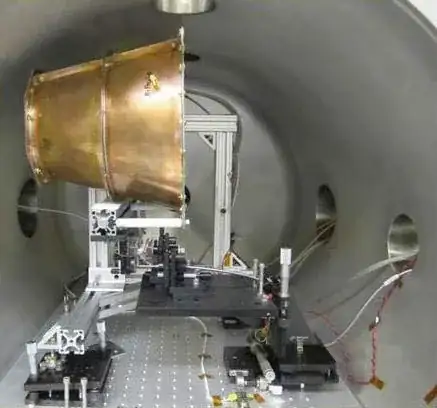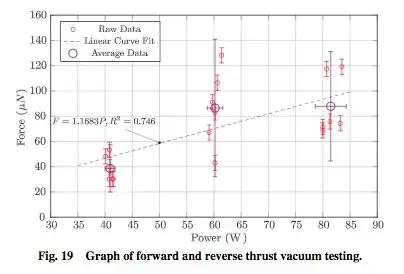Apply a mechanism that induces a physical effect on the vacuum that causes sufficient numbers of the virtual particles to emerge moving in the same direction. Assume the virtual particles have a component of motion. If the particles are charged and if the chamber in which the virtual particles are moving in a collimated flux, can apply an electromagnetic field to decelerate the charged virtual particles.
Basically it is a gigantic particle accelerator that instead of accelerating the virtual particles "steals" momentum from them.
The process of polarizing the emergence of virtual particles from the quantum vacuum is a purely hypothetical concept. Hypothetical to the point of calling it a fiction as there is no known physical mechanism to justify or explain it. But it could pass muster in science-fiction.
The scale and power of the linear particle accelerator required to transfer momentum from the polarized virtual particle flux is uncertain, but is presumably many orders of magnitude beyond anything that human technology can achieve in the foreseeable future.
The quantum vacuum is effectively a sea of virtual particles in all possible momentum states. Any propulsive system utilizing them would have to work by sequestering an excess of virtual particles to emerge with a momentum spectrum capable of acting as a propulsion system.
John Baez's FAQ on virtual particles deals with both momentum and energy conservation of virtual particles. This is explained in terms of quantum mechanical perturbation theory.
Some descriptions of this phenomenon instead say that the energy of the system becomes uncertain for a short period of time, that energy is somehow "borrowed" for a brief interval. This is just another way of talking about the same mathematics. However, it obscures the fact that all this talk of virtual states is just an approximation to quantum mechanics, in which energy is conserved at all times. The way I've described it also corresponds to the usual way of talking about Feynman diagrams, in which energy is conserved, but virtual particles can carry amounts of energy not normally allowed by the laws of motion.
This explained here in clearer terms:
The concept of virtual particles arises in the perturbation theory of quantum field theory, an approximation scheme in which interactions (in essence, forces) between actual particles are calculated in terms of exchanges of virtual particles. Such calculations are often performed using schematic representations known as Feynman diagrams, in which virtual particles appear as internal lines. By expressing the interaction in terms of the exchange of a virtual particle with four-momentum q, where q is given by the difference between the four-momenta of the particles entering and leaving the interaction vertex, both momentum and energy are conserved at the interaction vertices of the Feynman diagram.
Consideration of issues about virtual particles in relation to momentum and energy conservation is a good idea. However, quantum mechanics has definitively answered this: the conservation laws apply and aren't a problem.
Note: For those who care about this sort of thing: The hypothetical virtual particle propulsion system proposed above is undoubtedly a form of Maxwell's demon and would have all the usual problems associated with it.
References:
Froning, H. D., Jr. (1980) “Propulsion Requirements for a Quantum Interstellar Ramjet”, Journal of the British Interplanetary Society, Vol. 33, No. 7, pp. 265-270.
Froning, H. D., Jr. (1985) “Use of Vacuum Energies for Interstellar Flight”, MDC paper H1496, 36th Congress of the International Astronautical Federation, October, Stockholm, Sweden.
Froning, H. D., Jr. (2003) “Investigation of a 'Quantum Ramjet for Interstellar Flight'”, MDAC paper G7887, AIAA/SAE/ASME 17th Joint Propulsion Conference, Colorado Springs, July, CO.
Froning, H. D., Jr. and Roach, R.L. (2002) “Preliminary Simulations of Vehicle Interactions with the Quantum Vacuum by Fluid Dynamic Approximations”, paper AAIA-2002-3925, American Institute of Aeronautics and Astronautics, Washington, DC.
Froning, H. D., Jr., Barrett, Terence W., and Hathaway, George (1998) “Experiments Involving Specially Conditioned EM Radiation, Gravitation and Matter”, paper AAIA-98-3138, American Institute of Aeronautics and Astronautics, Washington, DC.
Minami, Y. (2008) “Preliminary Theoretical Considerations for Getting Thrust via Squeezed Vacuum”, Journal of the British Interplanetary Society, Vol. 33, No. 7, pp. 315-321.
Fiction where the concept has been used:
Charles Sheffield, The McAndrew Chronicles (New York: Tor Books, 1983)
Arthur C Clarke, The Songs of Distant Earth (New York: Ballantine/Del Rey, 1986)

